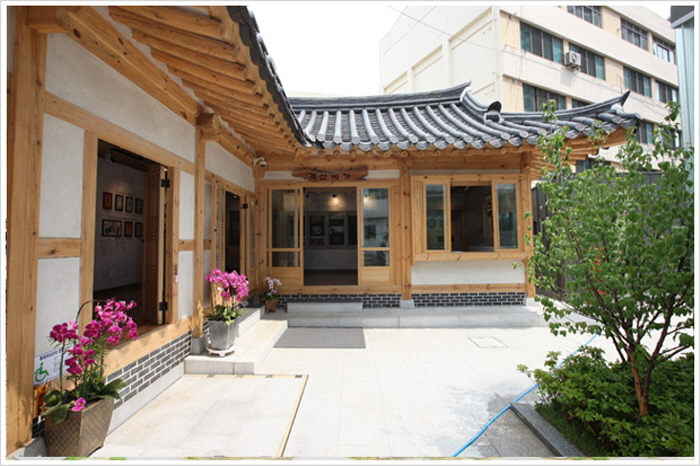House of Yi Sang-hwa (이상화 고택)
8.7Km 2023-01-06
6-1, Seoseong-ro, Jung-gu, Daegu
+82-53-256-3762
Yi Sang-hwa was a nationalist poet, who resisted the Japanese colonialism. This was his house from 1939 until his death in 1943. His house was neglected after he died, until a citizens' movement in 1999 to preserve the house urged the Military Mutual Aid Association to purchase it, and donate it to the City of Daegu on October 27, 2005. It has been restored and opened to the public, serving as the center for education of the poet's brave spirit and work.
Modern History Experience Hall Gyesanyega (근대문화체험관 계산예가)
8.7Km 2021-04-27
6-1, Seoseong-ro, Jung-gu, Daegu
+82-53-661-3323
Modern History Experience Hall Gyesanyega opened in 2012 is a public space designed for rest and education. Visitors can enjoy a moment of relaxation while touring Daegu Modern Culture Alley, as well as learn more about the history of the area through the video hall and about the houses featured along the way, such as House of Yi Sang-hwa and House of Seo Sang-don, at the hanok exhibition hall.
House of Seo Sang-don (서상돈 고택)
8.7Km 2021-07-01
6-1, Seoseong-ro, Jung-gu, Daegu
+82-53-256-3762
The house of entrepreneur and activist Seo Sang-don is located in the heart of Daegu. In 1907, in an effort to repay national debt and to gain independence from Japan, Seo launched the National Debt Repayment Movement as well as a nationwide campaign calling for people to quit smoking.
In celebration of Seo's leadership, the City of Daegu restored Seo's old house and opened it to the public. The City also built the National Debt Repayment Park and erected a statue of Seo in his honor.
Daegu Goods - Daegu Branch [Tax Refund Shop] (대구굿즈 대구)
8.7Km 2024-04-19
1F, 69, Seoseong-ro 14-gil, Jung-gu, Daegu
-
Apsan Cafe Street (앞산카페거리)
8.7Km 2023-11-17
191 Daemyeongnam-ro, Nam-gu, Daegu
+82-53-627-1337
Apsan Cafe Street is filled with cafes of all different types. From houses modified into a cafe, restaurants, and gallery cafes, there are more than 40 coffee shops along the street. Most are cafes serving coffee, sandwichs, and desserts, but there are also restaurants serving pizza, pasta, and steak as well as Japanese food, pubs and pie shops. The street is perfect for couples going on a date or families looking for sweets. Attractions nearby include Apsan Park and Anjirang Gopchang Alley for a place to eat, drink and rest. Anjirang Station (Daegu Subway Line 1) is also 5-10 minutes away on foot.
Daegu Gyesan Cathedral (대구 계산동성당)
8.7Km 2024-07-31
10 Seoseong-ro, Jung-gu, Daegu
+82-53-254-2300
Daegu Gyesan Cathedral is one of Daegu's main churches, designed by Father Poisnel, who also designed Myeongdong Cathedral and imported stained glass for the windows directly from France. Being located in the city center, the cathedral is especially beautiful when seen at night.
Olive Young - Kyungpook Nat’l Univ. Branch [Tax Refund Shop] (올리브영 경북대)
8.8Km 2024-04-18
85-1, Daehak-ro, Buk-gu, Daegu
-
Eldis Regent Hotel (엘디스 리젠트 호텔)
8.8Km 2021-02-11
2033, Dalgubeol-daero, Jung-gu, Daegu
+82-53-253-7711
Situated in the heart of the city of Daegu, Eldis Regent Hotel is in close proximity to domestic financial institutions, government offices, Daegu World Cup Stadium, and Daegu Stadium. The European-style business hotel has up-to-date central heating, ventilation, and air conditioning systems and each of the eight different types of guestrooms are equipped with soundproof windows. Hotel facilities include a jazz bar (“Blue Chicago”), and a fitness club outfitted with modern weight and workout equipment.
The hotel is located near a transfer subway station, making it easy to reach many shopping districts of Daegu. Lotte Department Store, Hyundai Department Store, and Daegu Department Store, as well as traditional Seomun Market are all within walking distance of the hotel, making Eldis Regent Hotel a favorite accommodation among shoppers. Various medical clinics are located nearby with Yangnyeongsi, a tourist site known for its 350 years of history in traditional Korean medicine, a mere 3-minute walk from the hotel.
March 1st Independence Movement Road (3·1만세운동길)
8.8Km 2023-01-20
Dongsan-dong, Jung-gu, Daegu
March 1st Independence Movement Road is a historical location where Daegu citizens gathered for the independence movement on March 8, 1919, and the midpoint of Daegu Modern Alley Tour Course 2. Passing Cheongna Hill Missionary's House and Jeil Church, you will come to a road with murals of the independence movement. The March 1st Independence Movement Road is a hilly road leading to Gyesan Cathedral. It is also called 90 Stairs because there are 90 steps. On the wall of the stairs, there is an augmented reality (AR) experience zone along with site photos from history. By scanning the QR code is a 3D video that vividly reproduces the independence movement, enabling a realistic experience of history. Follow the signs of the Daegu March 8th Independence Movement marching road to reach the main road and it will lead to the the 100th anniversary monument of the March 1st Movement and the starting point of the March 8 Movement. A guided alley tour is available for free with an online reservation on the official website.
Dongsan Cheongna Hill (동산청라언덕)
8.8Km 2024-10-25
2029 Dalgubeol-daero, Jung-gu, Daegu
+82-53-627-1337
Cheongna Hill is the place where Christian missionaries resided during the early 20 century, planting many ivies along the site. It is also called Dongsan Cheongna Hill for being on the eastern side of Daegu's center. There are many attractions in this beautiful garden including Chamness’ House, Switzer’s House, Blair’s House, 90 stairs, Daegu 3.1 Independence Movement Road, Daegu's first western apple tree, a memorial stone inscribed with the song "Thinking of My Friend” , and the cemetery of the missionaries and their family. Cheongna Hill is also the starting point of Daegu's Street Tour Course 2 as well as a popular drama film location.



![Olive Young - Kyungpook Nat’l Univ. Branch [Tax Refund Shop] (올리브영 경북대)](http://tong.visitkorea.or.kr/cms/resource/14/2883914_image2_1.jpg)
 English
English
 한국어
한국어 日本語
日本語 中文(简体)
中文(简体) Deutsch
Deutsch Français
Français Español
Español Русский
Русский